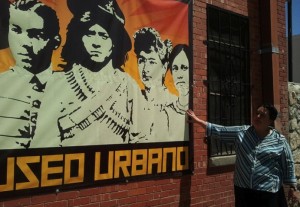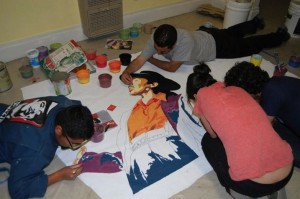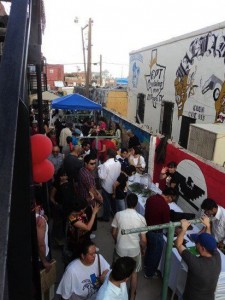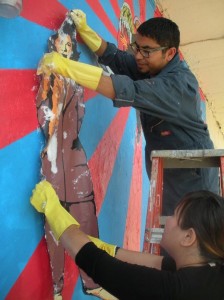Hardball history: On the high road without any shoes
02 April 2015 – Yolanda Chávez Leyva
conference, Hardball History, advocacy, social justice, public engagement, community history, sense of place, collaboration, museums, economic development, race
 “You know who has money to help you.” I responded to this truth by listing three millionaires from whom I would not accept funding for Museo Urbano, the public history project housed in the Department of History at the University of Texas at El Paso (UTEP). The response hit hard. “You know you’re walking the high road, but you don’t have any shoes on.” I smiled at the image, but inside my heart sank.
“You know who has money to help you.” I responded to this truth by listing three millionaires from whom I would not accept funding for Museo Urbano, the public history project housed in the Department of History at the University of Texas at El Paso (UTEP). The response hit hard. “You know you’re walking the high road, but you don’t have any shoes on.” I smiled at the image, but inside my heart sank.
Funding has been one of the most difficult challenges in my career as a public historian. It is an issue that I have grappled with since my days as a student activist in the 1970s. How do we fund social justice initiatives while still maintaining our sense of ethics and responsibility? Whose money is acceptable and whose is not?
That day three years ago, I wondered how Museo Urbano’s work could continue without financial backing. Yet, accepting funding from the people who “had the money” would mean losing the trust of the community that I had worked with for years, whose history I had researched for decades, and the place where my own family had lived almost a century ago. Going to the people “who had the money” meant asking for funding to tell the story of a neighborhood from the very people who planned its destruction. It would mean undermining my own sense of ethics and responsibility. I knew I couldn’t do it.
Almost a decade ago, the city announced a new downtown redevelopment plan, created by an alliance of developers and the city government. The plan included the demolition of a large portion of the El Segundo Barrio, despite its significance as one of the most important Mexican American/Mexican immigrant barrios in the US and with no regard to the thousands of people living there.
Museo Urbano’s work was then and continues to be centered south of the railroad tracks in the contested territory of El Segundo Barrio and the Mexican American neighborhoods that grew to the east of it a century ago, along the river dividing the United States and Mexico. Emerging as a grassroots effort in the midst of this political fight to stop the demolition, students made up the majority of those working with Museo Urbano. Because of this, we incorporated it into UTEP’s public history program in 2006, with students researching and writing a short history of El Segundo that we distributed in the community.
 History was evoked on all sides of the struggle over El Segundo Barrio. Early on, the city paid $100,000 for a branding study that proclaimed that El Paso, represented by a photograph of an older Mexican gentlemen in a cowboy hat, was “dirty,” “gritty,” “uneducated,” and “Spanish-speaking.” Their portrayal of “dirty” Mexicans harkened back to a painful history. Negative depictions of Mexicans had pervaded the early 19th-century writings by Americans entering what would eventually become the Southwest, as well as the anti-Mexican immigrant rhetoric of much of the 20th century. Still, its 21st-century revival in the midst of a struggle to save a neighborhood from demolition was shocking.
History was evoked on all sides of the struggle over El Segundo Barrio. Early on, the city paid $100,000 for a branding study that proclaimed that El Paso, represented by a photograph of an older Mexican gentlemen in a cowboy hat, was “dirty,” “gritty,” “uneducated,” and “Spanish-speaking.” Their portrayal of “dirty” Mexicans harkened back to a painful history. Negative depictions of Mexicans had pervaded the early 19th-century writings by Americans entering what would eventually become the Southwest, as well as the anti-Mexican immigrant rhetoric of much of the 20th century. Still, its 21st-century revival in the midst of a struggle to save a neighborhood from demolition was shocking.
History was fought over in the newspapers and on the streets. The local newspaper published articles that undermined our contention that the history of El Segundo was significant. If we said El Segundo’s history was the patrimony of two nations, the plan’s supporters found a historian to say there was nothing worth saving there. Academic studies of South El Paso had been used for decades to diminish the worth and potential of its people. Residents asked us how history could be used to save their neighborhood.
 By 2010, we had a space in El Segundo, funded by a state grant with assistance from UTEP. The community embraced Museo Urbano, located in the two tiny tenement apartments where the Mexican barrio, the African American neighborhood, and the old Chinatown had once intersected. Through photographs and text, we told the rich history of the neighborhood and the diverse people who had built it.
By 2010, we had a space in El Segundo, funded by a state grant with assistance from UTEP. The community embraced Museo Urbano, located in the two tiny tenement apartments where the Mexican barrio, the African American neighborhood, and the old Chinatown had once intersected. Through photographs and text, we told the rich history of the neighborhood and the diverse people who had built it.
Artists, cultural workers, high school and university students, activists, neighborhood leaders, and community residents worked tirelessly to make Museo Urbano a beautiful and welcoming place. Often, they worked for free, out of pure devotion to what it represented–recovering the untold histories of la frontera, the border. It was not about telling the stories of oppression and tragedy, although the history of injustice and oppression was present in every nook and cranny of the museum. It was about highlighting the resilience, creativity, and strength of the people who made their lives in what is one of the poorest zip codes in the United States. It was about honoring the dignity of the people, as the director of the Border Farmworker Center, Carlos Marentes, always told us.
The people needed a place where they could experience their histories with self-worth, a place that engendered confianza y respeto, trust and respect. It was about the history of a place that developers did not think should exist.
 The challenge of funding remains. In recent years, we have become a “museum without walls,” working with community partners who offer us spaces to share the history of the border while listening to the people of the border. We create exhibits that are mobile. We hold dialogue programs in meeting spaces. We mount historical photos on the walls of buildings. Students and community members continue to work with a dedication and joy that always touches me.
The challenge of funding remains. In recent years, we have become a “museum without walls,” working with community partners who offer us spaces to share the history of the border while listening to the people of the border. We create exhibits that are mobile. We hold dialogue programs in meeting spaces. We mount historical photos on the walls of buildings. Students and community members continue to work with a dedication and joy that always touches me.
The decision to “walk the high road” even without shoes has kept us true to our work in the community. In our neighboring state of Chihuahua, the Rarámuri people run marathons, traversing mountains and valleys, often without shoes. My grandmother came from them. I often think of that day four years ago when walking barefoot was tossed at me as a caution. I’ve turned it into a political principle, one that speaks of responsibility and strength in the face of sacrifice. I walk without shoes, but I am not alone.
~ Yolanda Chávez Leyva is the Chair of the Department of History and an Associate Professor at the University of Texas at El Paso.
All photos of Museo Urbano are courtesy of the author.




Yolanda,
Thank you for writing and sharing this. Your courage, perseverance and compassion for your community and students have made more of an impact than any “shoes” or large gifts could ever have. Your ability to make an impact and show how history is relevant to contemporary issues with so few resources is inspiring. Sometimes, clients tell me “But we don’t have the resources to make an impact” I say – look at what Yolanda is doing!
Thank you for your support, Conny. I always remember my mama telling me how she hand-sewed curtains with some cheap fabric to use as a “door” when we drove by the tenement where she lived as a young woman, “Mi’ja, just because you are poor doesn’t mean you can’t create something beautiful.”
I totally second Connie’s praise. If I wanted to make a small donation, to whom and where would I send it?
I, like you, Yolanda, believe that sticking to my principals is worth much more than millions of dollars from those who would tear you down.
Thank you so much for your comments. We welcome donations. Go to the website of the Department of History at UTEP (www.academics.utep.edu/history) , click on the “Give Now” icon on the top right corner, click on “Museo Urbano.” This will take you to the Development website where you designate “Museo Urbano” under “other.” Or, feel free to send a check to: Yolanda Leyva, Department of History, 500 W. University Avenue, UTEP, El Paso, TX 79968. We appreciate all donations! Thank you so much, Parker.